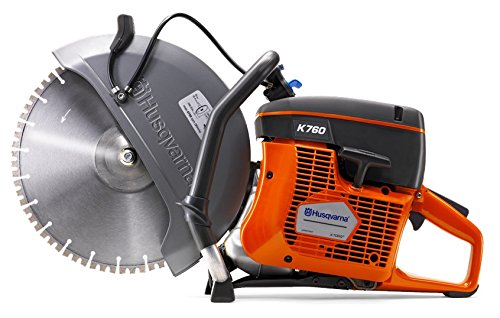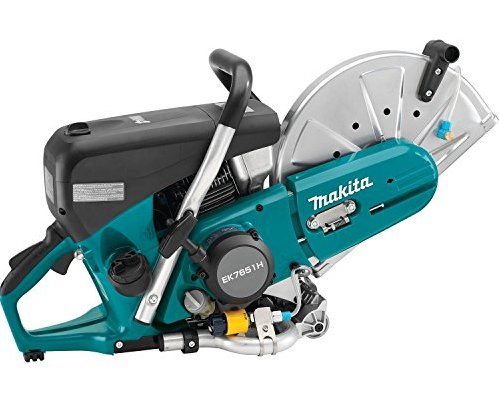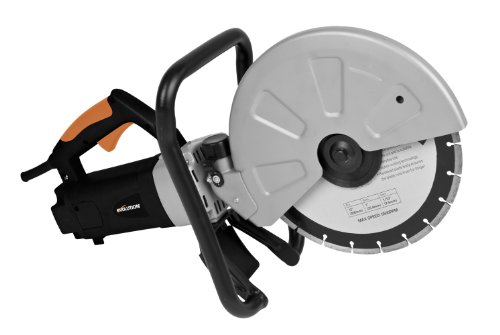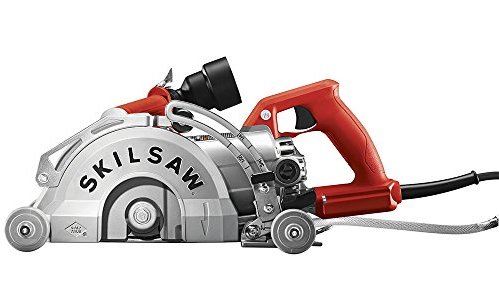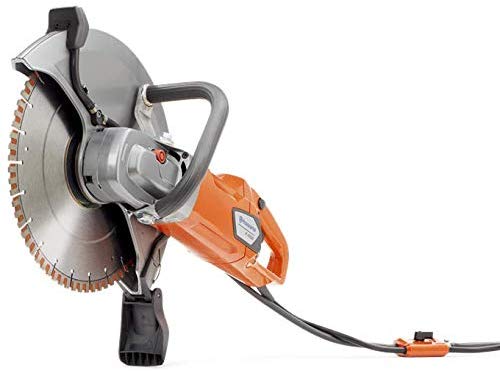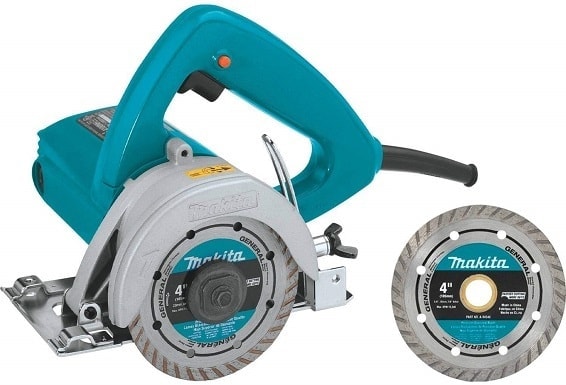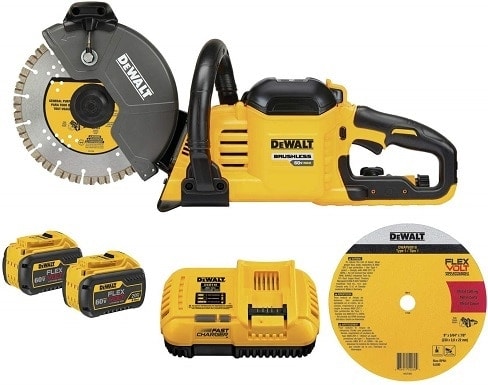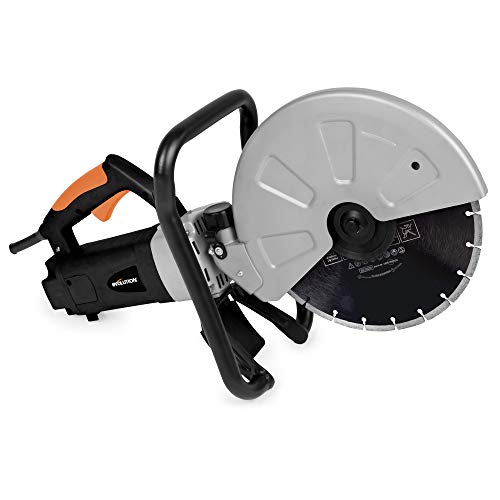10 Best Concrete Saws – Reviews & Buyer’s Guide 2025
-

- Last updated:
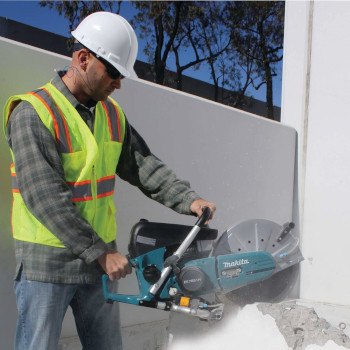

Cutting concrete is a bit more involved than a simple woodworking task. Because concrete is not easy to get through, you will need a powerful and heavy-duty saw. In addition to the size, most concrete saws are also wet saws.
If you plan on using your concrete saw on a professional job site, you must ensure you get an industrial-grade saw. If, however, you want to work on your back patio and improve your landscaping, a homeowner or consumer model will be just fine. We compiled a list of the 10 best concrete saws of the year with reviews to help you select the ideal model.
A Summary of our Favorites (updated in 2025)
| Rating | Image | Product | Details | |
|---|---|---|---|---|
Best Overall
 |
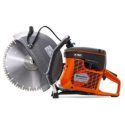 |
Husqvarna K770 Concrete Saw |
|
CHECK PRICE |
 |
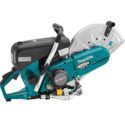 |
Makita 14-Inch Gas Concrete Saw |
|
CHECK PRICE |
Best Value

|
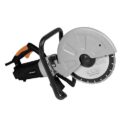
|
Evolution Concrete Saw |
|
CHECK PRICE |
|
|

|
Metabo CM4SB2 Concrete Saw |
|
CHECK PRICE |
|
|

|
SKILSAW Worm Drive Concrete Saw |
|
CHECK PRICE |
The 10 Best Concrete Saws
1. Husqvarna K770 Concrete Saw – Best Overall
The Husqvarna K770 Concrete Saw has too many positive features to discuss them all, but we will give you some key points to help you understand why the Husqvarna jumps to the top of our list. It is a versatile saw that you can use to cut a curb or pavers. The Husqvarna has dust handling, vibration, and sound-dampening features to make the saw user-friendly.
The K770 comes with a 1-year consumer warranty and no professional warranty. As much as we love this saw, it will probably not be a go-to saw for a professional outdoor landscaper or road work company. It is a 5-HP model, and it has a very tight-fitting and comfortable-to-use water hookup.
We didn’t notice any leaks, and adjusting the water flow into the unit is easy. The Husqvarna is a perfect concrete saw for residential users. Overall, we think that the K770 is the best concrete saw this year.
- Low vibration
- Active air filtration
- Low fuel consumption
- Dust-sealed starter
- Difficult first start
2. Makita 14-Inch Gas Concrete Saw
The Makita EK7651H 14-Inch MM4 concrete saw changes out the two-stroke engine found in most gas-powered saws for a four-stroke engine. While this doesn’t lead to a direct increase in power, it has many other benefits. For instance, you can use regular gas in a four-stroke engine instead of the 50:1 gas-to-oil mix needed in two-stroke engines.
While no saw of this power could ever be described as “quiet,” the Makita is quieter than competing saws of a similar size, which you’ll appreciate while using it. It also comes with a five-stage, foam-paper-nylon filtration system, which does an excellent job of keeping dust out of the engine and significantly extends its life.
However, this model is very slow starting, sometimes requiring five or more pulls to turn over. It also costs hundreds of dollars more than our top model. It’s powerful, however, so you must decide if you value the four-stroke engine at such a premium over a two-stroke with similar power.
- Four-stroke engine
- No oil mixing required
- Lower noise
- Excellent filter
- Slow starting
- Expensive
3. Evolution Concrete Saw – Best Value
If you are here for the value pick, this is your saw. The Evolution Concrete Saw is the best concrete saw for the money. The Evolution can cut through concrete, stone, brick, and other materials. Although this saw is not as large or powerful as other models, it may be all you need to complete the job.
The Evolution has an electric motor, and you won’t be dealing with as large and bulky a unit as the gas-powered Makita. Also, you won’t need to worry about checking the gas whenever you want to operate the saw.
The design of this saw is a good one when it comes to user comfort and ease of use. The Evolution comes with a 12-inch diamond blade, even at this low price. If you have a few projects lined up where you may need a concrete saw, the Evolution is an excellent choice. You won’t have to do much-continued maintenance, and at this price point, you will likely save yourself money from having a professional do the job.
- Electric motor
- Low maintenance
- Fast blade changes
- Price
- Corded electric tool
4. Metabo CM4SB2 Concrete Saw
The Metabo CM4SB2 is one of the more portable models on our list, but it has some significant flaws. It is a circular saw, and it functions differently from the other models so far. It has easy depth adjustment with a one-touch level, which is handy if you’re only cutting part of the way through something.
It produces fewer vibrations and weighs between half and a third of what other models on this list weigh, making it a good choice for anyone who doesn’t want to be worn out by their tools. However, the Metabo is a circular saw, and it lacks a bevel adjustment. There are some complaints about the saw not coming at a perfect 90-degree angle, so there’s some potential for frustration.
Likewise, it has average power at best. This isn’t a tool with industrial power, so it’s a good choice for people doing jobs at home but lacks the power for many construction work.
- Easy depth adjustment
- Low vibration
- Weight
- No bevel adjustment
- Not very powerful
5. SKILSAW Worm Drive Concrete Saw
The SKILSAW SPT79-00 Worm Drive Saw is, as the name would suggest, a worm drive saw. It’s narrower and longer than a direct-drive circular saw. That makes it better for cuts in tight spaces and typically cuts better with the same amount of power used. This model is electric, which means it’s low maintenance, but you also need a power outlet available if you want to use this saw. It comes with retractable pointer guides, which makes following a pre-drawn line very easy.
The SPT79-00 is compatible with a dry or wet dust management system, and it’s GFCI protected, so you’re safe to use water with it even though it’s an electric tool. However, the dry dust management system doesn’t work the best and leaves lots of dust behind. It can also only support 7″ blades. You won’t get nearly as much depth as you would with our top models, which use 12″ or 14″ blades.
- Wet/dry dust management
- Electric
- Retractable pointer guides
- Inefficient dry dust collection
- Small blade
6. XtremepowerUS Concrete Saw
Equipped with a 14-inch blade powered by 15 amps, the XtremepowerUS wet/dry cement saw is a very capable beast. It’s electric, so no gas or oil is needed, and it’s never difficult to start. Hook your hose up to it, and you’ll get steady streams of water to keep the blade nice and cool while you make your cuts.
However, you’ll need a trip to the hardware store to get a connector for your hose since, from the factory, this tool doesn’t have one. The motor has an overload shutoff to stop it from overheating, which meant that we had to work in 2-minute intervals. While this is great for the tool’s longevity, it’s not for productivity. This saw is priced quite moderately, putting it in most homeowners’ range.
- 15 amps
- Affordable
- Needs hose connector
- Have to work in 2-minute intervals
7. Husqvarna K4000 Concrete Saws
This powerful 15-amp wet saw from Husqvarna makes short work of standard cuts in cement, though it’s missing a few essential features. It’s priced at a premium, so we don’t expect to see such vital features missing. It is a fully electric concrete saw powered by a standard home outlet. That means it won’t make your cuts quite as fast as a gas saw would.
At 17 pounds, it’s a burly saw. Most other saws of this power and weight include a set of rear wheels to rest the saw on during use, allowing it to slide forward while cutting. Unfortunately, the Husqvarna does not have any wheels. This makes it much more difficult to use. Another thing missing is the blade, so you’ll have to shell out even more to pick up a blade for your new saw.
- Electric
- Very powerful
- No rear wheels
- Doesn’t come with a blade
- Very high priced
8. Makita 4100NHX1 Concrete-Saw
This cement saw from Makita is very compact and portable. It has a shallow cut depth of 1⅜ inches, and you can’t use it for heavy-duty jobs. However, it’s very light at only 6.5 pounds and much more manageable than the large wet saws. Of course, that’s another drawback. This is not a wet saw and doesn’t have hookups for water.
The 9.6-amp motor is powerful for the small 4-inch blade size, and it cuts through concrete quickly with little effort. Although this saw operates well, since it can’t make the large cuts often necessary of a cement saw, it’s capped out at the eighth position on this list.
- Portable
- No water hookups
- Small 4” blade
- Only makes 1⅜” cut
9. DEWALT DCS690X2 Concrete Saws
Although this Dewalt FLEXVOLT cordless cement saw is powerful and works well, it has a few flaws that can’t be ignored. To start, it uses a blade that only Dewalt makes. You won’t find it at your local home improvement store, so when the blade gets dull (and it will) you will be dealing with a headache replacing it.
Moreover, the batteries that power the saw will not even last 10 minutes. Until this machine can run for 20-30+ minutes on a charge, it won’t be very useful. Despite these significant drawbacks, the FLEXVOLT is expensive. While it is undoubtedly a very capable tool, the faults outweigh the benefits.
- Terrible battery life
- Very expensive
- Blades are hard to replace
10. Makita EK7651H Saw for Concrete
Makita is a well-respected manufacturer of power tools, and some of their cement saws are excellent hard-working products. However, the EK7651H missed the mark by a significant distance. Let’s start with what it does well. For what it is, it’s quiet, doesn’t vibrate too badly, and it’s powerful. The saw seems to be pretty decent so far. What’s bad about it?
For one thing, it doesn’t start well! To use it for dry cutting, you must take half the tool apart to change filters. Speaking of dry cutting, this saw hates the dust, which constantly seems to clog and cause it to run terribly, often shutting off. We don’t think this saw lives up to the Makita name. Considering the price, it just doesn’t seem like the best investment.
- Quiet for a cement saw
- Poor starting
- Changing filters is laborious
- Doesn’t run well when dry cutting
- Very expensive
Buyer’s Guide – Choosing the Best Concrete Saw
Hopefully, our reviews already have you thinking about which features you’d like to see in your next concrete saw. There are many features you need to consider before you buy, so if you’re unsure how to pick the right model for yourself, check out this buyer’s guide.
Electric vs Gas
Electric tools have been around for a while, but they’ve made a big push in the last few years because of advancements in electric engines and batteries. While you’d be hard-pressed to find a concrete saw that uses a battery, some corded electric models are worth your consideration.
Electric
Corded electric models tend to be far lighter than gas-powered models. They don’t have a fuel tank, which cuts down on the weight and bulk, and the electric engine is more compact and weighs much less.
While it’s hard to find a heavy-duty concrete saw that weighs less than 20 pounds, you can often find electric models that weigh less than 10 pounds, and they could weigh as little as one-third as much as an equivalent gas-powered model.
They also don’t produce any emissions, so they’re better for the environment and for people sensitive to gas fumes. Since they don’t have any moving parts, they don’t need as much maintenance and break down less often. However, you have to remember that these models require an electric outlet, so you’ll need access to a power supply to use them.
- Compact and lightweight
- Zero emissions
- Low maintenance
- Tethered to a power source
- Not as powerful
Gas
Gas-powered models are the clear winners when it comes to portability. While they often weigh more, they don’t use a power cord, so they’re suitable for situations where you won’t have easy access to power. The models with the most power are all gas-powered, so if you’re looking for something for industrial or construction use, you’ll want a gas-powered concrete saw.
More power also means more speed in the same job relative to an electric model, so gas-powered is the way to go if speed is of the essence.
- Portability
- Excellent power
- Fast
- High maintenance
- Dependant on the fuel source
You should keep in mind that gas-powered concrete saws can come with two-stroke or four-stroke engines, which have different requirements that are explained in the section below.
Two-stroke vs four-stroke engines
Two-stroke
Two-stroke engines are more common in handheld power tools than four-stroke engines. While the name may imply that the four-stroke engine is more powerful than the two-stroke engine, that isn’t the case. Instead, the number of strokes refers to how the engines use oil for lubrication.
Two-stroke engines have fewer moving parts, so they tend to be smaller. They also start much more quickly. Usually, one or two pulls are enough to start them, as opposed to four-stroke engines, which often require far more.
They can’t use standard gas, however. They need to have gas and oil mixed before it’s poured into the fuel tank, and that means that you either need to buy a special blend or do the mixing yourself.
- More common
- Fewer moving parts
- Quick starting
- Need a gas-oil mixture
- Not as long-lasting as a four-stroke
Four-stroke
The four-stroke engine has two extra strokes dedicated to lubricating the moving parts with oil. This reduces wear on the parts relative to a two-stroke engine, and four-stroke engines should last longer. They have more moving parts, and more can go wrong, but if you care for it properly, you should see a longer life out of a four-stroke engine than a similar two-stroke.
You can use standard gasoline with a four-stroke engine, though you will likely want to find a gas station that doesn’t add ethanol into the mix as smaller four-stroke engines frequently don’t handle it well. You must also add engine oil through a separate valve on the tool.
Two-stroke engines won’t last as long as four-stroke, so you shouldn’t expect them to last forever, but good models should give you many years of excellent service. Two-stroke engines also have better fuel economy and produce fewer fumes, so if you want a model that excels in those areas, go with a two-stroke engine.
- Long-lasting
- Can use standard gas
- Fast
- More emissions
- Needs oil
Safety
Concrete saws are among the most dangerous power tools known to man. After all, they cut through concrete. Just think what they could do to human flesh and bone. You’ll want to wear protective equipment when operating a concrete saw like any advanced power tool. However, eye protection (goggles) is the most important item. Concrete saws kick up a lot of debris, and there’s no way to control where it goes.
Check out the video below for more concrete saw safety tips.
Conclusion:
The Husqvarna 967181002 is our top model due to its low vibration, active air filtration, and low fuel consumption. The Makita EK7651H 14-inch MM4 concrete saw is a good choice for people who want a four-stroke engine but is likely too pricey for people who don’t prefer two-stroke and four-stroke engines. The Evolution DISCCUT1 is a great electric model available at a low price, making it the best value on our list.
We hope our reviews and buyer’s guide have helped you learn about concrete saws. Armed with this information, you should be able to find the best concrete saw for your workshop.
Contents
